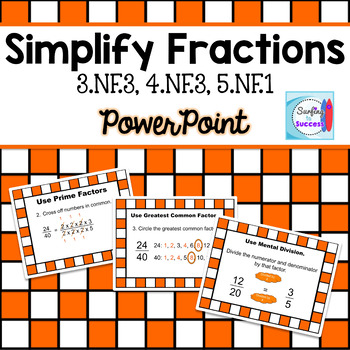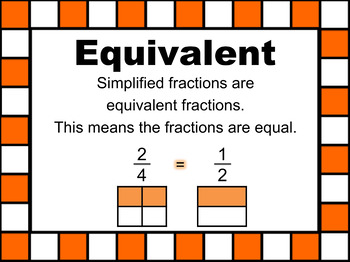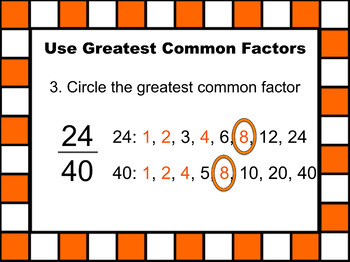Simplify Fractions Powerpoint
Mercedes Hutchens
7.3k Followers
Grade Levels
3rd - 5th, Adult Education
Subjects
Resource Type
Standards
CCSS3.NF.A.3
CCSS4.NF.B.3
CCSS5.NF.A.1
Formats Included
- PPTX
Pages
53 pages
Mercedes Hutchens
7.3k Followers
What educators are saying
This is a great resource for students with learning disabilities. My students were able to use it and follow along. They were engaged and loved it. Thank you!
Also included in
- Are your students starting to add fraction and subtract fractions with like denominators?This Add and Subtract Fractions and Simplify Bundle will give your students practice adding fractions with like denominators with and without simplifying (reducing fractions). Save 20% by buying this bundle! APrice $12.80Original Price $16.00Save $3.20
Description
This PowerPoint can be used to introduce three strategies for simplifying fractions: using prime factors, using greatest common factors, and using mental division. This reviews vocabulary and provides foldables.
The first 11 slides review vocabulary such as prime factors, greatest common factors, equivalent fractions and more.
The Powerpoint goes breaks each topic into step by step instructions and allows the students to attempt the skill on their paper, white board, or on the provided foldables. Two Foldables can be printed from the Powerpoint so students can keep track of the steps, attempt and example, and write down the strategy.
I wrote tips about using the foldable in your Interactive Math Notebooks, aka Math Journal, in the notes of the foldable slides.
I showed this Powerpoint on my Smart Board.
Do you have Google Accounts for your students? Consider the digital interactive version: Simplify Fractions: Interactive Math for the Google Classroom
Common Core Standards Addressed:
Fifth Grade Common Core Standard Mathematics Number & Operations in Base Ten 5.NBT.2 Explain patterns in the number of zeros of the product when multiplying a number by powers of 10, and explain patterns in the placement of the decimal point when a decimal is multiplied or divided by a power of 10. Use whole number
exponents to denote powers of 10.
Common Core Standards:
3.NF.3 Explain equivalence of fractions in special cases, and compare fractions by reasoning about their size.
a. Understand two fractions as equivalent (equal) if they are the same size, or the same point on a number line.
4.NF.3 Extend understanding of fraction equivalence and ordering.
1. Explain why a fraction a/b is equivalent to a fraction (n × a)/(n × b) by using visual fraction models, with attention to how the number and size of the parts differ even though the two fractions themselves are the same size. Use this principle to recognize and generate equivalent fractions.
5.NF.1 Use equivalent fractions as a strategy to add and subtract fractions.
1. Add and subtract fractions with unlike denominators (including mixed numbers) by replacing given fractions with equivalent fractions in such a way as to produce an equivalent sum or difference of fractions with like denominators.
This is part of my Add and Subtract Fractions Bundle.
The Add and Subtract Fractions Bundle includes:
Add Fractions with Like Denominators
Add Fractions with Like Denominators Then Simplify
Subtract Fractions with Like Denominators
Subtract Fractions with Like Denominators Then Simplify
Simplify Fractions PowerPoint
Check Out My Other Math Products:
Order of Operations PEMDAS Packet
Equivalent Fractions: Game, Vocabulary, and More (Common Core Resource)
Factoring: Factor Trees, Prime Factorization Games, Foldable, and More
Prime, Composite, or Neither? Game, Foldable, and More
Plot a Point in Quadrant 1 (Common Core Resource)
The first 11 slides review vocabulary such as prime factors, greatest common factors, equivalent fractions and more.
The Powerpoint goes breaks each topic into step by step instructions and allows the students to attempt the skill on their paper, white board, or on the provided foldables. Two Foldables can be printed from the Powerpoint so students can keep track of the steps, attempt and example, and write down the strategy.
I wrote tips about using the foldable in your Interactive Math Notebooks, aka Math Journal, in the notes of the foldable slides.
I showed this Powerpoint on my Smart Board.
Do you have Google Accounts for your students? Consider the digital interactive version: Simplify Fractions: Interactive Math for the Google Classroom
Common Core Standards Addressed:
Fifth Grade Common Core Standard Mathematics Number & Operations in Base Ten 5.NBT.2 Explain patterns in the number of zeros of the product when multiplying a number by powers of 10, and explain patterns in the placement of the decimal point when a decimal is multiplied or divided by a power of 10. Use whole number
exponents to denote powers of 10.
Common Core Standards:
3.NF.3 Explain equivalence of fractions in special cases, and compare fractions by reasoning about their size.
a. Understand two fractions as equivalent (equal) if they are the same size, or the same point on a number line.
4.NF.3 Extend understanding of fraction equivalence and ordering.
1. Explain why a fraction a/b is equivalent to a fraction (n × a)/(n × b) by using visual fraction models, with attention to how the number and size of the parts differ even though the two fractions themselves are the same size. Use this principle to recognize and generate equivalent fractions.
5.NF.1 Use equivalent fractions as a strategy to add and subtract fractions.
1. Add and subtract fractions with unlike denominators (including mixed numbers) by replacing given fractions with equivalent fractions in such a way as to produce an equivalent sum or difference of fractions with like denominators.
This is part of my Add and Subtract Fractions Bundle.
The Add and Subtract Fractions Bundle includes:
Add Fractions with Like Denominators
Add Fractions with Like Denominators Then Simplify
Subtract Fractions with Like Denominators
Subtract Fractions with Like Denominators Then Simplify
Simplify Fractions PowerPoint
Check Out My Other Math Products:
Order of Operations PEMDAS Packet
Equivalent Fractions: Game, Vocabulary, and More (Common Core Resource)
Factoring: Factor Trees, Prime Factorization Games, Foldable, and More
Prime, Composite, or Neither? Game, Foldable, and More
Plot a Point in Quadrant 1 (Common Core Resource)
Total Pages
53 pages
Answer Key
N/A
Teaching Duration
90 minutes
Report this resource to TPT
Reported resources will be reviewed by our team. Report this resource to let us know if this resource violates TPT’s content guidelines.
Standards
to see state-specific standards (only available in the US).
CCSS3.NF.A.3
Explain equivalence of fractions in special cases, and compare fractions by reasoning about their size.
CCSS4.NF.B.3
Understand a fraction 𝘢/𝘣 with 𝘢 > 1 as a sum of fractions 1/𝘣.
CCSS5.NF.A.1
Add and subtract fractions with unlike denominators (including mixed numbers) by replacing given fractions with equivalent fractions in such a way as to produce an equivalent sum or difference of fractions with like denominators. For example, 2/3 + 5/4 = 8/12 + 15/12 = 23/12. (In general, 𝘢/𝘣 + 𝘤/𝘥 = (𝘢𝘥 + 𝘣𝘤)/𝘣𝘥.)






